|
 Secure Site
Secure Site
|
 |
Archive for the 'Now & Zen Alarm Clocks' Category
 yoga, sooth frazzled nerves pose Friday: Soothe Frazzled Nerves
As another hectic workweek slows to a close, it’s time to downshift — and ramp up your self-care.
Friday’s pose quiets your mind and nervous system, restoring your inner resources so that you can fully enjoy the weekend ahead.
Supported Child’s Pose
What It Does
Releases the muscles in the back, gently opens the hips, boosts your energy.
How to Do It
Set your Zen Timepiece to gong after 5 minutes. Sit back on your heels with your legs folded under you and the tops of your feet on the floor. Open the knees wide and bend forward at the hips.
Rest your forehead (or your chest) on a pillow or blanket and keep your arms slightly bent. If your buttocks don’t reach your heels, place a blanket under your thighs. Relax and breathe deeply for 5 minutes, until your Zen Yoga Timer gongs.
adapted from Body + Soul, 2010
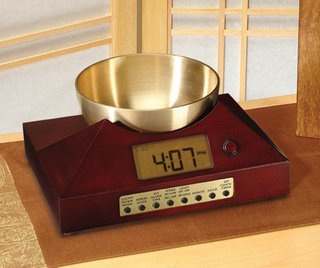 Zen Timepiece with brass singing bowl, a yoga timer
Now & Zen
1638 Pearl Street
Boulder, CO 80302
(800) 779-6383
Posted in Bamboo Chime Clocks, Chime Alarm Clocks, Japanese Inspired Zen Clocks, Meditation Timers, Meditation Tools, Now & Zen Alarm Clocks, Well-being, Yoga Timer, Yoga Timers by Now & Zen, Zen Timepiece by Now & Zen, Zen Timers
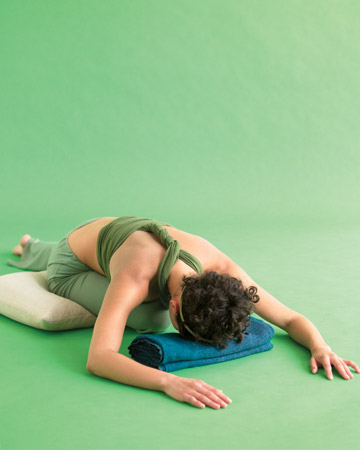 yoga, clear out the gunk pose Clear out the Gunk
What if I don’t get this done in time? Why hasn’t she called? Worries have been accumulating — and they’re cluttering your head. Left unchecked, even the tiniest stressors will inhibit your best ideas from coming through.
Treat yourself to a few moments of stillness with this pose, and watch your inspiration re-emerge.
Supported Pigeon
What It Does
Opens the hips and groin, lets go of stress and pent-up emotions, quiets the mind, and promotes emotional release.
How to Do It
Set your Zen Yoga Timer for 5 minutes so the the chime with end your practice in a calm way. Sitting cross-legged on the floor, swing your left leg around, extending it straight out behind you, tops of the feet and toes against the floor. Fold forward at the hips.
For added support, put a folded blanket or pillow under the right hip. Rest your forehead on a cushion or blanket and relax into the pose 5 minutes until your Zen Timer end with a chime. Repeat with the other leg.
adapted from Body + Soul Magazine, 2010
 Digital Zen Yoga Timer in Walnut Finish Use our unique “Zen Clock” which functions as a Yoga Timer. It features a long-resonating acoustic chime that brings your meditation or yoga session to a gradual close, preserving the environment of stillness while also acting as an effective time signal. Our Yoga Timer & Clock can be programmed to chime at the end of the meditation or yoga session or periodically throughout the session as a kind of sonic yantra. The beauty and functionality of the Zen Clock/Timer makes it a meditation tool that can actually help you “make time” for meditation in your life. Bring yourself back to balance.
Now & Zen – The Yoga Timer Store
1638 Pearl Street
Boulder, CO 80302
(800) 779-6383
 The Zen Yoga Timer and Alarm Clock Store
Posted in Bamboo Chime Clocks, Now & Zen Alarm Clocks, Yoga Timer, Yoga Timers by Now & Zen
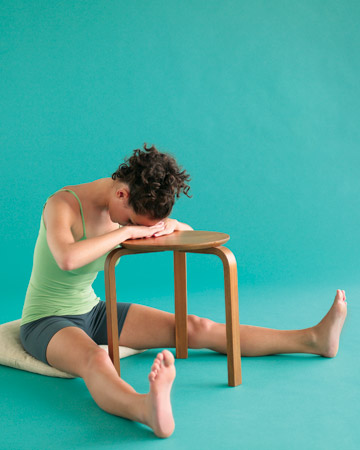 yoga think clearly pose Tuesday: Think Clearly
You can feel the stress mounting. Remember to take things slowly and stay loose as you find your rhythm. Use this gentle stretch to help undo back and leg tension and keep you grounded and steady.
Supported Seated Forward Bend
What It Does
Stretches hamstrings and inner thighs, releases tension along the spine. Quiets the mind and promotes focus, stimulates the sixth chakra, which activates intuition and wisdom.
How to Do It
Set your Zen Yoga Timer for 5 minutes so that the calm chime will end your practice. Sit on a cushion on the floor with your legs extended on either side of a chair. Fold forward at the hips and rest your forehead and arms on the seat of the chair. Take deep, slow breaths through your nose and hold for 5 minutes.
adapted from Body + Soul, 2010
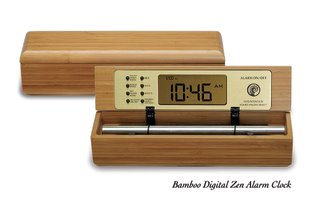 Bamboo Digital Chime Clock, a calming timer and alarm clock made from natural materials like bamboo, walnut, and maple Now & Zen
1638 Pearl Street
Boulder, CO 80302
(800) 779-6383
Posted in Bamboo Chime Clocks, intention, Now & Zen Alarm Clocks, Yoga Timer, Yoga Timers by Now & Zen
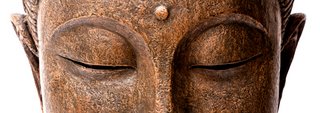 Buddha Maybe your next vacation should be a journey inward.
On the path to the hot springs at Tassajara Zen Mountain Center, I begin a kind of walking meditation, a continual awareness of what I am doing right now. Now I am crossing a footbridge to the baths, now I am taking off my flip-flops, now I am standing in front of an altar and reading the calligraphy: “With all beings/I wash body and mind/free from dust/pure and shining/within and without.”
“Guess my name,” says the little girl who shares the Japanese-style outdoor pool with me.
“Okay. Emma,” I say.
“Do you know her?” her mother asks, puzzled.
“No,” I say, “she just looks like an Emma.”
I’m not clairvoyant, but at retreat centers people converge in unexpected ways. Beyond the pool, past the sun-bleached sycamores on the far side of the creek, seven naked women in sun hats carefully wind their way upstream. There’s something mischievous about them as they wander in haphazard single file. I try to give them a context: Are they workshop participants hunting for wild mushrooms? Who knows? I think of the Zen notion of beginner’s mind, ready for anything, open to everything…and, silently, I thank Emma and the naked women for being here, for opening my mind.
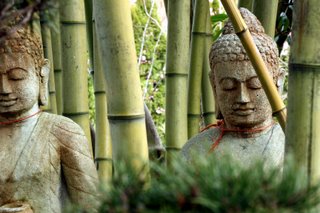 Buddhas In my mid-30s, I became an inveterate retreater. With two small kids, time to myself seemed a thing of the past. So I began to take week-long breaks, alone and seeking contemplation, at cabins, in farmhouses, on islands. Along the way, I discovered one retreat that offered me contemplation as a way of life shared by an entire community. Tassajara is the place I return to year after year.
Slowing way down is the first gift of Tassajara, and slow is the only way to drive the 14-mile dirt road that climbs through the Los Padres National Forest and over a 5,000-foot ridge of the Santa Lucia Mountains to the retreat. I stop and look down the steep descent through firs, sugar pines, tanbark oaks, and madrone into the canyon cut by Tassajara Creek. I exhale deeply, sloughing off my half-day drive south from San Francisco and a few layers of anxiety that have accumulated since my last visit here — the war and its threat to all of us with draft-age children, my divorce driving its way toward finality.
An open gate leads travelers to Tassajara, also known as Zenshin-ji (Zen Mind Temple), founded in 1966 by Japanese Soto Zen priest Shunryu Suzuki Roshi and the San Francisco Zen Center. The first Soto Zen monastery outside of Asia follows a traditional monastic schedule during the fall, winter, and early spring, then opens for guest season from late April through early September.
At Tassajara, where electricity is largely confined to the dining room and kitchen, cell phones don’t work, and a single public telephone is more trouble than it’s worth, guests are offered another way — the way of retreat. Here, the scheme of things is clear. One’s small place in it, uncomplicated.
 Digital Zen Alarm Clocks and Timers, available in maple, walnut, bamboo, and black lacquer Whether here or elsewhere, there are a number of ways to have a retreat. Retreats are times to turn inward, to quiet down, to let your own needs take precedence. At Tassajara, free from cars, buses, jobs, and family responsibilities, you simply bathe, eat, sleep, sit in meditation (or not, as you choose), swim, hike, read. You might venture to the massage kiosk to be kneaded, tapped, stretched, and unblocked. The day’s big excursion could be swimming some laps in the spring-fed creek-side pool, or hiking a mile downstream to a tumble of large boulders and small waterfalls you can ride down to the local swimming hole. Feeling more energetic, you might hike one of the trails — my favorite being up the mountain to the Wind Caves, where you can sit inside shallow, white-sand-floored pockets in the granite cliff face and behold the top of the world. You can return for the organic vegetarian meals, a cuisine pioneered by Tassajara’s Ed Brown and Annie Somerville, the chef of the Zen Center’s San Francisco restaurant, Greens.
Another way of visiting Tassajara is as a workshop participant. “Zen and Yoga” marks a turning point in my retreat life — a threshold to greater community, one that adds structure to my retreat time. With my daughter away at college and my teenage son spending every other week at his dad’s, I no longer crave alone time as I once did. Instead, I’m looking for ways to realign myself in relationship to others. In this context, retreat becomes an active verb.
My workshop takes place in the meditation hall, or zendo, where over the next three days we will examine how sitting meditation and the practice of yoga postures, or asanas, inform and enhance one another. I have brought my Zen Meditation Timer to end my meditation. It’s taught by Victoria Austin, a long-time Zen priest and yoga teacher who is also president of the San Francisco Zen Center. The afternoon we arrive, Victoria introduces us to the statue of a sitting Buddha that dominates the altar in the middle of the hall. When a fire destroyed the old zendo some years ago, the stone statue exploded into hundreds of pieces. Painstakingly reconstructed, the Buddha is almost exactly like the original, but not quite. “This Buddha is like practice itself,” Victoria reminds us. “You’re always putting yourself back together, each time a little differently.” I can relate to that; we all can. Practice reaches far beyond the yoga or meditation mat to include, ultimately, each moment of our waking lives.
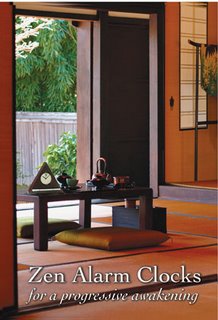 Tea Room with Zen Clock and Timer After restorative yoga, dinner, and an evening plunge in the hot springs, I’m as relaxed as I’ve ever been, in a comfy bed in my roomy turn-of-the-century cabin, lulled to sleep by the sound of water tumbling over creek stones. I’m awakened before dawn by the boom of a mallet striking a wooden block, calling the entire community to meditate in the zendo. An hour of sitting sorely reminds me of all the muscles it takes to sit that long, that straight. After temple cleaning, my workshop group continues with asana practice, all 25 of us spread out over the zendo, assuming Mountain, Tree, and Triangle poses, the Warrior series, and all the standing poses to fully awaken.
Famished, at breakfast I have a hard time choosing between the offerings: polenta with fresh strawberries, kiwis, and bananas, and the pancakes with raspberry compote. I sit at a table in the dining hall overlooking the creek with three women stem-cell researchers from Stanford University, a woman running for county supervisor, and a Minnesota man who founded a successful marketing firm. Busy lives and type-A personalities are a common bond for many people attracted to retreats.
Later that day, I talk to the gregarious guy from Minnesota. “I’m usually shy and standoffish, judgmental,” he admits to me, “but I decided to pay attention yesterday during sharing time.” He pauses to let a little cynical emphasis grin through. “I felt completely drawn to each story; it made me want to engage with everyone here.” I found myself wishing I’d done that. “Funny what’s possible,” he says.
It’s been a day of intense physical work, experimenting with yoga poses that help strengthen our meditation posture and focus our attention. Lying still, during Savasana, our last pose, Victoria says to us, “Let sounds come to you rather than pulling in the sounds.” I drift in and out, aware of the sound of footsteps on the gravel path, of the squawk of the ubiquitous blue jays, but most of all of our sighing — an ongoing chorus vocalizing the deep pleasure of exertion and release, a natural by-product of the primary work we are doing: following our breath in and out.
The next night at Victoria’s dharma talk, she compares the monks’ winter practice at Tassajara to one long breathing in, or refreshing the practice, and the summer guest season to a long breathing out, or giving to the larger community. I resolve to work on that out-breath.
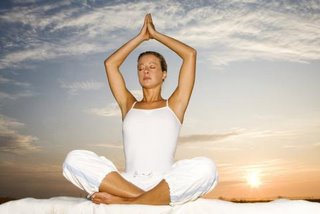 yoga Afterward the low light of kerosene lanterns dimly illuminates the path back to my cabin. I stop to watch the new moon rising above steep black slopes.
It is summer solstice night. Looking deeper, into the bright and scattered stars, I feel as if I’m standing in a roofless cathedral, buttressed by the Santa Lucias, part of some great force tilted upward in praise. My body tingles from the demands of the day, fledgling upper-back muscles awakened, all my cells celebrating in active communion. Attention. I whisper the word to myself, like an ancient secret. I raise my arms to the new moon in thankful salutation, take a long breath in, and sigh it westward, down the path of the year’s longest day.
For reservations call (415) 865-1895 or visit sfzc.org/tassajara/.
Adapted from Body + Soul, April/May 2005
Posted in Bamboo Chime Clocks, Hot Springs, Japanese Inspired Zen Clocks, Meditation Tools, mindfulness practice, Now & Zen Alarm Clocks, Well-being, zen monks
 exhaustion cures - setting your Zen Alarm Clock Are you feeling stressed, fatigued, and burned out? Discover the top 10 ways to put a stopper in your personal energy drains
Consider this simple question: How are you?
We answer it 10 times a day, often rejoining with a clipped “Fine” or “Busy!” accompanied by a glazed smile. But when your best friend or spouse asks, perhaps you tell the deeper truth: You’re stressed out and tired. Really tired.
“Busy,” “stressed,” and “tired” are intimately connected. They describe the ethos of our times — and its inevitable aftermath. We balance work, family, friends, and our various self-improvement programs. We take in a steady stream of information from the people, screens, phones, and sounds that surround us. We don’t sleep enough. We multitask like crazy, striving to get more done in less time.
For a while, maybe even years, it’s easy to feel like you can handle this frantic pace — or even thrive at it. But ultimately, it works against you. “Stress is pervasive in our society, and it’s only getting worse,” says integrative-medicine expert Woodson Merrell, M.D., author of “The Source: Unleash Your Natural Energy, Power Up Your Health, and Feel 10 Years Younger.” “And people do not necessarily have the coping skills to deal with it, even when they think they do.” We often don’t realize how much of our days are spent dealing with stressful situations, and on a physiological level, the effects of stress add up. “You don’t start every day with a clean slate,” he says. “You start the day with all the stress you’ve accumulated in your life, and you add to that.”
No wonder we’re so tired. In fact, many experts contend that chronic stress and our inability to cope with it are the biggest factors in fatigue. “I hear it all the time. People tell me, ‘I have no energy, I can’t sleep, I’m exhausted,'” says Andrew Weil, M.D., director of the Arizona Center for Integrative Medicine at the University of Arizona and author of “Healthy Aging.”
This “tired-wired” state has become a cultural condition, he adds. And for those that struggle with it, fatigue can also become a significant crisis. “Your personal energy level should meet the demands of the day. Your sense of well-being should be good most of the time,” says Weil. “When it’s not, you have a real quality-of-life shortage.”
As is always the case, however, in crisis lies opportunity. Fatigue, it turns out, can be a terrific teacher, giving you a chance to slow down and examine your life, learn more about yourself, and consider what’s really important.
For starters, you want to cover your bases by eating a healthy diet, getting regular exercise, maintaining good sleep habits, and following other steps toward sound overall energy hygiene. But many of our most potent energy drains fly under the radar. By taking careful stock of your daily habits, work life, and relationships, you can begin to see patterns that cause your vitality to slip away unnoticed; make some simple changes, and you’ll plug these leaks and start feeling better. Choosing a gentle, chiming Alarm Clock to awaken you in the morning could be step 1.
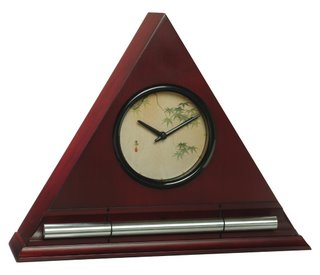 Japanese Leaves Dial Face in Burgundy Finish by Now & Zen Here, Merrell, Weil, and other experts highlight 10 surprising causes of fatigue and offer thought-provoking solutions to help you energize your mind, body, and spirit — and your life.
1. Exhaustion Cause: Good News
We know that our energy gets drained by negative events: death of a spouse, divorce, imprisonment, getting fired, serious illness or injury, losing your home or savings. But positive events can drain us, too, says Alice Domar, Ph.D., executive director of the Domar Center for Mind/Body Health in Waltham, Massachusetts. “Getting married, having a baby, buying a new house, getting promoted at work — these are all positive steps, but they often come with a lot of worry, which can be exhausting.”
To further complicate the picture, it’s hard to find support when things are going great. “Tell people you’re exhausted because you’re caring for your dying mother, and you’ll get all the support in the world,” Domar says. “Tell them you’re exhausted because you got a fantastic new job, and they’ll be like, ‘Give me a break!’ ”
Exhaustion Cure: Make a Positive Prep Plan
The best way to end-run positive exhaustion? Prepare for it. “When you start getting tired,” says Domar, “ask yourself two questions: ‘What’s being asked of me that I don’t feel that I can deliver?’ and ‘Am I accurately perceiving what’s needed?'” Then make a list of what really needs to be done, and when. “We often feel like everything needs to happen at once, and that’s not true,” says Domar. Breaking things down into manageable chunks lets you catch your breath so you can plan and delegate accordingly.
adapted from Body + Soul, September 2009
 Digital Zen Alarm Clocks, available in maple, walnut, bamboo, and black lacquer
Now & Zen
1638 Pearl Street
Boulder, CO 80302
(800) 779-6383
Posted in Bamboo Chime Clocks, Chime Alarm Clocks, Japanese Inspired Zen Clocks, Natural Awakening, Now & Zen Alarm Clocks, Sleep Habits
When you apply a few simple techniques, you can turn your daily walk into a rewarding practice.
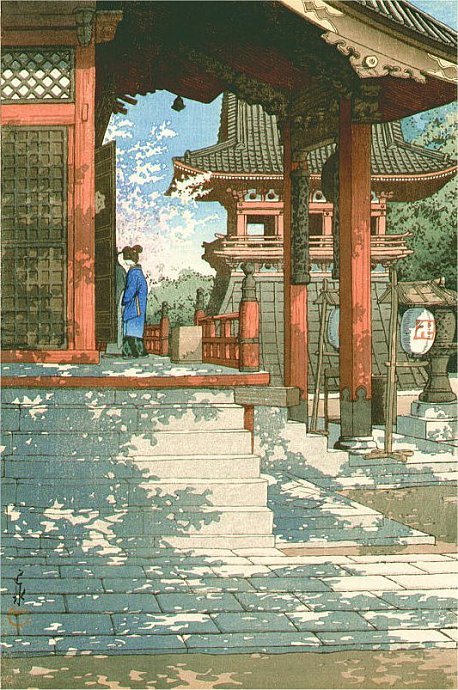 Hasui-b, Meguro Fudo What is mindful walking? It’s a technique that uses awareness of the mind/body connection to improve the quality of your walking experience on all levels. By approaching a walk in a mindful way, you make it a practice like yoga, meditation, or tai chi; every session brings new insights and challenges. As in yoga, you think about your body position, breathing, movements, and awareness, turning inward and outward at the same time. You’re working to get fit, and to improve your life as a whole. Treat walking as a practice, and it will become not only something you do with your legs but also a way to bring your mind, body, and spirit into balance.
Five Steps to Make Walking a Mindful Practice
- Identify your intention. The key to any mindful activity, intention provides focus and motivation, elevating your practice from routine to ritual. What is your intention? To walk for an hour every day? To develop a sense of centeredness and calm? To reduce stress? Your goals and intentions will evolve as you evolve. Let them, as long as they keep you in line with your higher sense of purpose — and keep you moving forward.
- Be consistent. A true practice requires ongoing attention. Of course, it’s natural to feel resistant at times, no matter what kind of activity you do. Your mind will create a thousand excuses not to walk today. Don’t let these passing thoughts distract you from your deeper intention. Get moving; start walking around your office or home, or wherever you are. You can quiet the mind by moving your body and get yourself back on track.
- Train your mind to focus. The mind loves — and craves — engagement. Without something to focus on, it will tend to wander, taking your practice with it. By learning to focus, you will be able to walk more efficiently.
- Listen to your body. As with any relationship, the connection between mind and body depends on how well one listens to the other. Our tendency is to try to rule the body with the brain; however, they are more like equal partners, offering feedback and direction as you go. Listen to what your body is trying to tell you by noticing any sensations that come up while you’re walking. You may feel energized as your leg muscles engage or relaxed as your breathing deepens. If you detect any complaint from your body, such as pain or discomfort, identify the source. Then make small adjustments in your technique and see whether the sensation lessens.
- Embrace the process. Goals provide a greater context for your practice. But building patient awareness of the process is even more important. Sometimes walking will feel easy and rewarding; other times, more like a chore. As part of a mindful practice, you accept the challenge as part of the process and continue to stick with it. My tai chi master sees difficulty as an opportunity — a lesson to be learned. Accepting all of these parts of the process lies at the heart of making walking a mindful exercise.
adapted from Body + Soul April/May 2006
 Digital Zen Alarm Clocks, meditation timers and alarm clocks with chimes
Now & Zen
1638 Pearl Street
Boulder, CO 80302
(800) 779-6383
Posted in Bamboo Chime Clocks, Goodness, Meditation Timers, Meditation Tools, mindfulness practice, Now & Zen Alarm Clocks, Well-being
 plum blossoms with moon The power of intention can be used to heal and promote good health, improve performance in many areas and even affect the future.
To be most effective, an intention should be a highly specific aim or goal, which you should visualize in your mind’s eye as having already occurred, while you are in a state of concentrated focus and hyper-awareness. When you imagine this future event, hold a mental picture of it as if it were occurring to you at that moment. Engage all five senses to visualize it in detail.
The centerpiece of this mental picture should be the moment you achieve the goal.
We might also improve the quality of our daily lives just by carrying out detailed mental rehearsals. At home, we might be able to send intentions to our children to perform better at school or to allow us to be more loving to friends and family. Human intention might be powerful enough to affect every element of our lives.
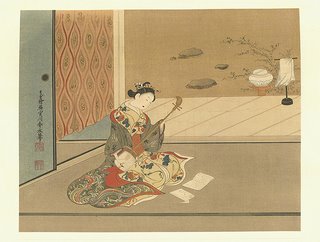 Shunsui Katsu-Miyagawa All of these possibilities suggest that we have an awesome level of responsibility when generating our thoughts. Each of us is a potential Frankenstein, with extraordinary power to affect the living world around us. How many of us, after all, are sending out mostly positive thoughts?
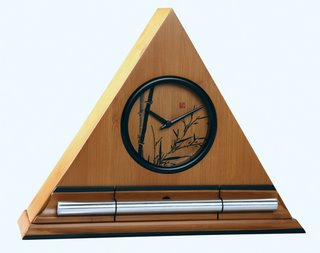 Bamboo Zen Clocks, progressive chime clock and timer
Adapted from Ode Magazine, Jan/Feb 2007 by Lynne McTaggart (The Intention Experiment: Using Your Thoughts to Change Your Life and the World, Free Press 2007)
Now & Zen
1638 Pearl Street
Boulder, CO 80302
Posted in Bamboo Chime Clocks, Chime Alarm Clocks, Goodness, intention, Japanese Inspired Zen Clocks, Meditation Timers, Meditation Tools, mindfulness practice, Natural Awakening, Now & Zen Alarm Clocks
 Kasamori Osen Ippitsusai Buncho SleepwalkingWhat causes it?
Sleepwalking is most common in children, who usually grow out of it. It’s a psychological issue, and when it continues into adulthood there’s typically two factors involved. “There tends to be some sort of hereditary component – it runs in families to some extent. And for people who are more susceptible to sleepwalking, times of stress bring it on,” says Professor Jim Horne, Director of the Sleep Research Centre at Loughborough University.
 Zen Alarm Clock How to beat it
When sleepwalking, nobody talks – they just babble incoherently. But in order to stifle your somnambulism, a long chat is the best medicine. “Try to get at the underlying cause,” says Horne. “It’s a simple case of talking to someone close to you about what’s on your mind. Just be matter-of-fact about it and take it from there.” Still find yourself stalking the corridors by night? A ccording to a study in the Annals of Neurology, sleep deprivation significantly increases the number of sleepwalking episodes experienced by predisposed individuals. Staying up past midnight stopped being cool long ago. Get your eight hours in.
adapted from Men’s Health, Ed Vanstone
Posted in Chime Alarm Clocks, Japanese Inspired Zen Clocks, Meditation Timers, Natural Awakening, Now & Zen Alarm Clocks, Sleep Habits
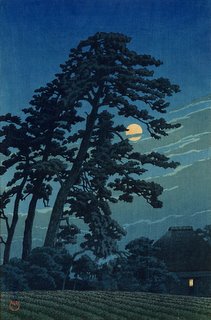 moonviewing, sweet slumber We spend up to a third of our lives asleep. Although some hard-driving people may view sleep as an inconvenience that curtails productivity and leisure activities, slumber is certainly no waste of time. In fact, sleep may play a more crucial role than diet or exercise in fostering optimal health.
A natural restorative, sleep offers an antidote to the damage done to our bodies during the day. It allows the body to replenish its immune system, eliminate free radicals, and ward off heart disease and mood imbalances. When sleep is disrupted—whether by lifestyle factors, insomnia, sleep apnea, narcolepsy, restless legs syndrome, jet lag, sleepwalking, night terrors, imbalance of hormones, or some other disorder—emotional and physiological health suffers. But you don’t have to accept sleep deprivation and the ills that accompany it. One way to gently snooze your way back to health is to focus on balancing your hormones.
Balance your hormones
The word hormone comes from the Greek hormon, meaning “to stir up.” Hormones are released by the various endocrine glands in the body in order to regulate energy production, growth, sexual development, stress responses, and many other functions. Because minute quantities of hormones can “stir up” so many activities in the body, when they are thrown out of balance the results can affect the entire body. Imbalances of Hormones often manifest as insomnia and other sleep problems. Key factors that can upset hormone levels include thyroid dysfunctions, perimenopause and menopause (in fact, disturbed sleep is one of the complaints that cause women to seek treatment for menopause and perimenopause), and andropause (the male form of menopause). Although hormone levels generally decline as a result of aging, they can also be affected by dietary choices, mineral deficiencies, environmental toxins and synthetic chemicals, medications, smoking, and stress.
Rather than artificially manipulating your estrogen levels with synthetic hormones and ignoring the reasons behind any imbalances of hormones, it is more valuable to determine why you have imbalances of hormones in the first place. Depending on the reason, restoring hormonal balance may be more effectively achieved with dietary changes, nutritional supplements, natural progesterone cream, herbal therapy, or traditional Chinese medicine tailored to the specific factors causing the imbalance of hormones.
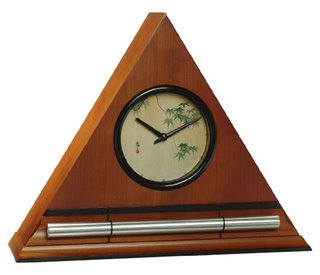 Zen Clock with Chime for a progressive awakening to sweet a slumber Now & Zen
1638 Pearl Street
Boulder, CO 80302
Excerpted from Alternative Medicine magazine’s Definitive Guide to Sleep Disorders: 7 Smart Ways to Help You Get a Good Night’s Rest (Celestial Arts, 2007)
Posted in Bamboo Chime Clocks, Chime Alarm Clocks, Japanese Inspired Zen Clocks, mindfulness practice, Natural Awakening, Now & Zen Alarm Clocks, Sleep Habits
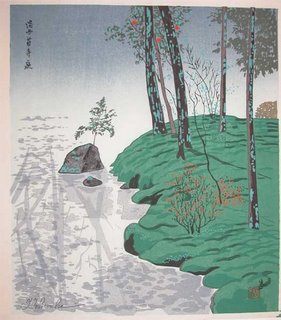 Garden of Kokedera Temple, Kyoto 1980, Tokuriki Almost everyone has a cherished memory of sleeping outdoors. A roof of stars, a cricket lullaby, the cool air on your face, awakening to the calls of birds and the first rays of the sun. It’s a welcome relief from the confines of a square room, stale indoor smells, and noisy appliances.
One particular outdoor sleeping experience made me a believer. A friend and I were camping in late summer at the edge of a meadow in an oak woodland. We kept it simple: sleeping bags rolled out on a tarp. The first night I remember thinking, Is nature always this noisy? How am I supposed to sleep? To my city-numbed senses, it was all new: the low moan of the wind in the tree branches, the crunching footfall of small animals on dried leaves, the hoot of owls, the distant howl of coyotes. And that moon—won’t somebody turn out the light?
But by the second night, the living world had woven me into its tapestry. I fell asleep easily, held by the earth, stroked by sweet breezes, reassured by the rustling of life all around me. When we broke camp a few days later, I felt like I was being torn from maternal arms. All my cells, newly accustomed to a deep sense of homecoming, told me that something precious was being left behind.
We were made for this stuff. Our ancestors were sleeping outdoors long before there were doors to sleep out of. Our senses, our psyches, our biological clocks are attuned to the rhythms of the sun and moon and the sounds, smells, and feel of the living web. When we sleep, we renew ourselves; there is no more important time to breathe clean, cool air and hear the thrumming of nature.
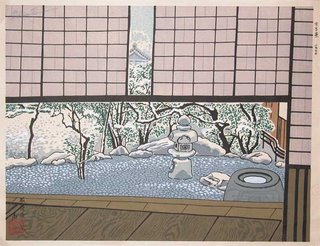 Teahouse at Daitokuji Temple, Kyoto by Tokuriki, 1977 Try this at home
If you need a breath of fresh air tonight, you can start inexpensively: Pitch a tent in the yard or pull your bed onto the deck in fair weather. I f you enjoy the experience, you may want to build a permanent sleeping porch or pavilion with a table for your portable Bamboo Zen Alarm Clock. Or you can alter an existing room to open up when the weather is pleasant; a wall of windows or doors that move aside can bring the outdoors to you.
adapted from Natural Home, July/August 2002 by Carol Venolia
 Zen Alarm Clock, Ukiyo-e Hokusai Wave Dial Face Now & Zen
1638 Pearl Street
Boulder, CO 80302
Posted in Chime Alarm Clocks, Japanese Inspired Zen Clocks, Now & Zen Alarm Clocks, Progressive Awakening, teahouse
« Previous Page — « Previous Entries
Next Entries » — Next Page »
|
|
|
|